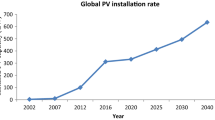Abstract
A novel lithium bromide/water mixed absorption refrigeration cycle that is suitable for the utilization of solar air-conditioning and can overcome the draw-backs of low system overall efficiency of traditional solar absorption refrigeration air-condition systems is presented. The accessorial high pressure generator was added in the cycle. The lithium bromide solution flowing out from the high pressure generator was mixed with the solution from the low pressure absorber to increase lithium bromide solution concentration and decrease pressure in the high pressure absorber. The performance of a mixed absorption refrigeration cycle was analyzed. The theoretical analysis shows that the highest COP is 0.61, while the highest available temperature difference of heat resource is 33.2°C. The whole coefficient of performance of the solar air-conditioning using mixed absorption cycle is 94.5% higher than that of two-stage absorption. The advantages of solar air-conditioning can be markedly made use of by the cycle.
Similar content being viewed by others
References
Assilzadeh F, Kalogirou SA, et al. Simulation and optimization of a LiBr solar absorption cooling system with evacuated tube collectors. Renewable Energy, 2005, 30(8): 1143–1159
Sumathy K, Huang Z C, Li Z F. Solar absorption cooling with low grade heat source—a strategy of development in South China. Solar Energy, 2002, 72(2): 155–165
Li Z F, Sumathy K. Technology development in the solar absorption air-conditioning systems. Renewable and Sustainable Energy Reviews, 2000, 4(3): 267–293
Pilatowsky I, Rivera W. Thermodynamic analysis of monomethylamine-water solutions in a single-stage solar absorption refrigeration cycle at low generator temperatures. Solar Energy Materials and Solar Cells, 2001, 70(3): 287–300
Assilzadeh F, Kalogirou S A, Ali Y. Simulation and optimization of a LiBr solar absorption cooling system with evacuated tube collectors. Renewable Energy, 2005, 30(8): 1143–1159
Fathi R., Guemimi C and Ouaskit S. An irreversible thermodynamic model for solar absorption refrigerator. Renewable Energy, 2004, 29(8): 1349–1365
Rivera W, Xicale A. Heat transfer coefficients in two phase flow for the water/lithium bromide mixture used in solar absorption refrigeration systems,Solar Energy Materials & Solar Cells, 2001, 70(3): 309–320
Mao Yishen, Yu Guohe. Absorption and Vapor Ejector Refrigerator, Beijing: China Machine Press, 1985 (in Chinese)
Yattara A, Zhu Y, Mosa Ali M. Comparison between solar single-effect and single-effect double-lift absorption machines (PartI). Applied Thermal Engineering, 2003, 23(15): 1981–1992
Author information
Authors and Affiliations
Corresponding author
Additional information
__________
Translated from Journal of Huazhong University of Science and Technology, 2006, 34(8): 62–64 [译自: 华中科技大学学报]
Rights and permissions
About this article
Cite this article
Wan, Z., Shu, S., Hu, X. et al. Research on performance of mixed absorption refrigeration for solar air-conditioning. Front. Energy Power Eng. China 2, 222–226 (2008). https://doi.org/10.1007/s11708-008-0017-2
Published:
Issue Date:
DOI: https://doi.org/10.1007/s11708-008-0017-2




